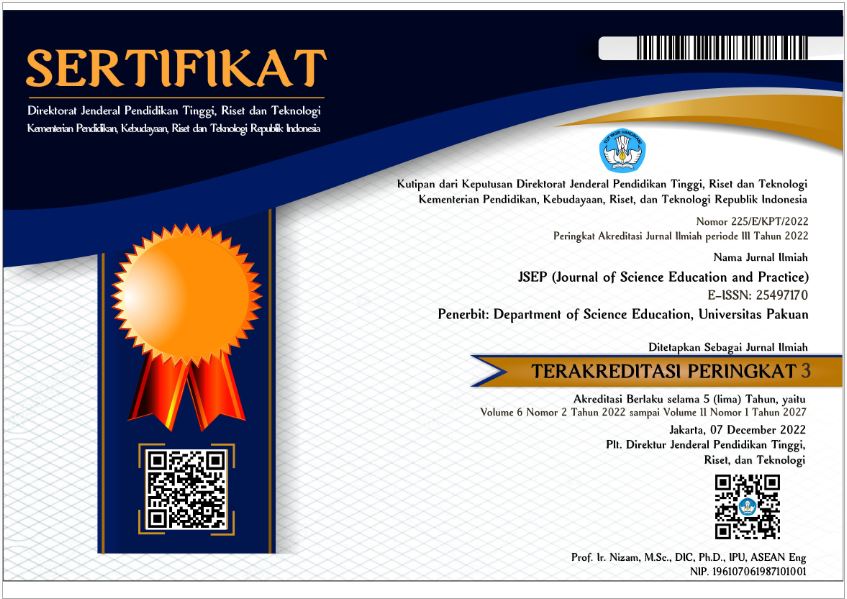ADDITIONAL MENU
Problem-Based Learning with Science, Technology, Engineering, and Mathematics (Stem) Approach to Improve Critical Thinking Skills and Conceptual Understanding of Junior High School Students
Abstract
Keywords
References
Arends, (2008), Learning to teach, Yogyakarta: Pustaka Pelajar,
Ennis, Robert H. 1985. A logical Basic for Measuring Critical Thinking Skills.
Moore, Tamara J and Gillian H. Roehrig. 2012. Considerations for Teaching Integrated STEM Education Micah Stohlmann. University of Minnesota, Twin Cities. Journal of Pre-College Engineering Education Research 2:1 2834.
Mustaffa, Najihah. Zaleha Ismail, Zaidatun Tasir, & Mohd Nihra Haruzuan Mohamad Said. 2015. The Impacts of Implementing Problem-Based Learning (PBL) in mathematics: A Review of Literature. Kementerian Pendidikan Malaysia, Faculty of Education Universiti Teknologi Malaysia Malaysia.
http://mdk12.msde.maryland.gov/index.html
Yuen, Timothy T. Melanie Boecking, Erin Price Tiger Alvaro Gomez, Adrienne Guillen and Analisa Arreguin Jennifer Stone.2014. Dynamics, and Interactions in Collaborative Robotics Projects with Elementary and Middle School. University of Texas at San Antonio Wichita State University.
Reynolds, Danielle (John A. Dubiski Career High School), Nur Yazdani (University of Texas at Arlington) Tanvir Manzur (Bangladesh University of Engineering and Technolog). 2013. STEM High School Teaching Enhancement Through Collaborative Engineering Research on Extreme Winds. Journal of STEM Education. Volume 14.
Han, Sunyoung, Robert Capraro And Mary Margaret Capraro.2014. How Science, Technology, Engineering, And Mathematics (Stem) Project-Based Learning (Pbl) Affects High, Middle, And Low Achievers Differently: The Impact of Student Factors on Achievement, International Journal of Science and Mathematics Education.
Prof. Dr. Ratna Wilis Dahar, M.Sc, 2011, Teori-Teori Belajar & Pembelajaran, Jakarta, Penerbit Erlangga
Paul Eggen, Don Kauchak, 2012, Strategi dan model Pembelajaran, Satrio Wahono, Jakarta, Penerbit Indeks
Fraenkel, Jack R and Norman E. Wallen. 2011. How to Design and Evaluate Research in Education. New York: McGraw-Hill High Education.
Hake, R. R. 1999. Analyzing Change/Gain Scores. http://www.physics.indiana. edu/~sdi/AnalyzingChange-Gain.pdf. Diakses tanggal 23 januari 2016.
DOI: 10.33751/jsep.v5i2.5699
 Abstract views : 1187
Abstract views : 1187
Refbacks
- There are currently no refbacks.
Copyright (c) 2021 JSEP (Journal of Science Education and Practice)

This work is licensed under a Creative Commons Attribution 4.0 International License.












